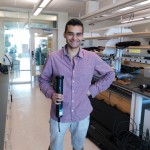Rodrigo Garcia
E-mail: rodrigo.garcia@umb.edu
Education
2015 PhD Curtin University, Dept. Physics and Astronomy, Remote Sensing
2011 BSc (Honours) Curtin University, Dept. Physics and Astronomy, Remote Sensing
2010 BSc (Honours) Curtin University, Chemistry Dept., Organic Geochemistry
Research Interests
Airborne hyperspectral remote sensing
Retrieving water quality parameters in shallow waters
Shallow water habitat and bathymetric mapping
Professional Experience
2015- PostDoc Research Fellow, School For the Environment, University of Massachusetts, Boston
2010-2011 Research Projects Officer, Marine Ecological Processes and Predictions Unit Commonwealth Scientific and Industrial Research Organization, Marine and Atmosphere Research
2009-2010 Internship, Marine Ecological Processes and Predictions Unit Commonwealth Scientific and Industrial Research Organiszation, Marine and Atmosphere Research
Awards
Curtin University, School of Science, O’Connor HDR Publication Prize, 2014
Publications
Garcia, R., & Hobbs, J-P. A. (in press). Diversity on the edge: non-linear patterns of coral community structure at an isolated oceanic island. Marine Ecology Progress Series, doi: 10.3354/meps11657
Garcia, R.A., Hedley, J.D., Hoang, C.T., & Fearns, P.R.C.S. (2015). A method to analyze the potential of optical remote sensing for benthic habitat mapping. Remote Sensing, 7, 13157-13189.
Richards, Z.T., Garcia, R.A., Wallace, C.C., Rosser, N.L., & Muir, P.R. (2015). A diverse assemblage of reef corals thriving in a dynamic intertidal reef setting (Bonaparte Archipelago, Kimberley, Australia). PLoS ONE, 10(2),e0117791.
Garcia, R.A., McKinna, L.I.W., Hedley, J.D, & Fearns, P.R.C.S. (2014). Improving the optimization solution for a semi-analytical shallow water inversion model in the presence of spectrally correlation noise. Limnology and Oceanography: Methods, 12, 651-669.
Garcia, R.A., Fearns, P.R.C.S., & McKinna, L.I.W. (2014). Detecting trend and seasonal changes in bathymetry derived from HICO imagery: A case study of Shark Bay, Western Australia. Remote Sensing of Environment, 147C, 186-205.
Garcia, R. A., Fearns, P.R.C.S., Keesing, J.K., & Liu, D. (2013). Quantification of floating macroalgae blooms using the scaled algae index. Journal of Geophysical Research: Oceans, 118, 26-42.
Keesing, J.K., Liu, D., Fearns, P., & Garcia, R.A. (2011). Inter- and intra-annual patterns of Ulvaprolifera green tides in the Yellow Sea during 2007-2009, their origin and relationship to the expansion of coastal seaweed aquaculture in China. Marine Pollution Bulletin, 62, 1169- 1182.
Technical Reports
Garcia, R.A., Fearns, P., & McKinna, L. (2014). Examining the potential of detecting change in HICO-derived bathymetry: a case study of Shark Bay, Western Australia, HICO User’s Annual Report II, Report to the HICO Project Office, Oregon State University, Remote Sensing and Satellite Research Group.
McKinna, L., Fearns, P., & Garcia, R.A. (2013). Shallow water products for the Hyperspectral Imager for the Coastal Ocean, in the Western Australian Satellite Technology and Applications Consortium (WASTAC) 2012 Annual Report, pp 38, WASTAC, Wembley, Western Australia.
McKinna, L., Garcia, R.A., & Fearns, P. (2012). Determining inherent optical properties, bathymetry and benthic types using HICO imagery within northeast and western Australiia, HICO User’s Annual Report I, Report to the HICO Project Office, Oregon State University, Remote Sensing and Satellite Research Group.
Conferences
21-26 Feb. 2016 Ocean Sciences Meeting, New Orleans, Louisiana, USA. Retrieval of Inherent Optical Properties in Optically Shallow Waters.
26-31 Oct. 2014 Ocean Optics XXII, Portland, Maine, USA. Optimal choice of spectral classes for higher precision benthic classification.
6-8 May 2013 International Ocean Colour Science Meeting 2013, Darmstadt, Germany. Routine Monitoring of bathymetry and habitat maps derived from HICO imagery: Case study of Shark Bay, Western Australia
3-7 July 2011 Australian Marine Science Association (AMSA), Fremantle, Western Australia, Australia. Quantification of floating macroalgae using the Scaled Algae Index (SAI)

